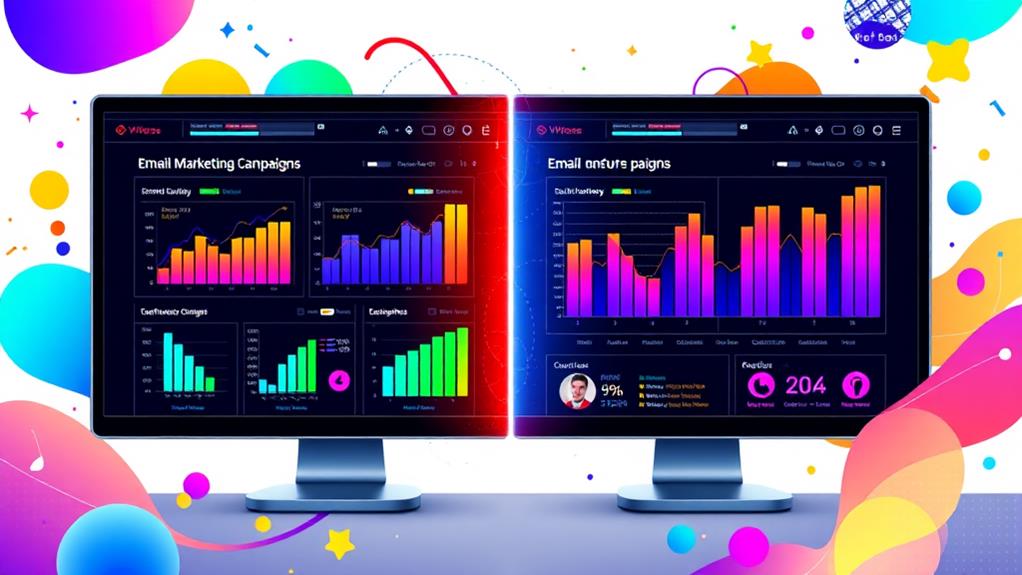Advanced A/B testing strategies can greatly boost email marketing efforts by optimizing key elements for enhanced audience engagement. Effective strategies include testing subject line variations, which can increase open rates by over 14%, and utilizing button CTAs that have shown to improve click-through rates by 27%. Employing multivariate analysis allows marketers to identify the best combinations of elements, while automated adjustments and longitudinal insights enhance real-time campaign optimization. To guarantee reliable results, focus on notable KPIs and utilize advanced platforms like Campaign Monitor and Optimizely. These strategies set the stage for deeper insights into successful email marketing optimization.
Key Takeaways
- Utilize multivariate analysis to test multiple variables concurrently for discovering optimal email campaign configurations.
- Implement AI-driven automated adjustments for real-time campaign optimization based on audience feedback and behavior.
- Focus on personalized content and audience segmentation to enhance engagement and response rates in email marketing.
- Leverage statistical significance with a p-value under 0.05 to ensure reliable and actionable testing insights.
- Document A/B test outcomes in a centralized repository for continuous learning and strategy refinement.
Understanding A/B Testing Basics
A/B testing, sometimes referred to as split testing, is an essential technique in email marketing that empowers marketers to make data-driven decisions by comparing two versions of an email campaign. This method involves sending these variations to a small, strategically chosen sample of a subscriber list to gauge performance, focusing on metrics such as open rates and click-through rates.
Test design is critical, as it involves selecting one or two elements to vary, such as subject lines or call-to-action buttons, allowing a precise analysis of which version resonates more with the audience.
In crafting a successful A/B test, careful sample selection plays a pivotal role. The sample must be representative of the larger subscriber base to guarantee valid results that can be extrapolated to the entire audience.
Tools like Mailjet and Campaign Monitor streamline this process, offering automation and detailed analytics for performance assessment. The insights gained from these tests can drive substantial enhancements in email marketing effectiveness, with some campaigns reporting over a 127% increase in click-through rates.
Continuous iteration through A/B testing is indispensable, enabling marketers to refine their strategies and align with audience preferences through informed, data-driven adjustments.
Key Elements to Experiment
Building on the foundational understanding of split testing, the next step involves focusing on the key elements to maximize the impact of your email campaigns.
These elements are essential for optimizing engagement and achieving measurable improvements in performance. A data-driven approach reveals several areas where A/B testing can yield noteworthy results:
1. Subject Line Variations: Experimenting with different lengths, tones, and levels of personalization in subject lines can increase open rates by over 14%.
Personalized content, such as including the recipient's name, can further enhance these effects.
2. Calls to Action (CTAs): Testing CTA placement, wording, and design is vital.
Button CTAs, for instance, can enhance click-through rates by 27% compared to text links, offering a tangible impact on conversion rates.
3. Personalized Content: Incorporating elements such as subscriber names or tailored messaging can boost relevance and engagement, leading to improved response rates.
This personalization fosters a stronger connection with recipients.
4. Visual Elements: The choice between images and text-only formats should be tested, as images might decrease conversions in specific contexts.
Understanding the visual preferences of your audience can guide better design choices.
These core elements, when strategically tested, can greatly enhance the effectiveness of your email marketing efforts.
Advanced Testing Techniques
In the domain of email marketing, advanced testing techniques offer a sophisticated approach to optimizing campaign performance through data-driven insights. Multivariate analysis stands out as a vital method, allowing marketers to assess multiple variables simultaneously. This approach identifies the most effective combinations within email campaigns, enhancing engagement and conversion rates.
By employing segmented audiences, marketers can tailor their experiments based on specific demographics and behaviors, guaranteeing that email content resonates more effectively with diverse recipient groups.
Automated adjustments further enhance optimization efforts by leveraging artificial intelligence to make real-time changes during campaigns. This dynamic capability guarantees that performance improvements are based on immediate feedback and audience interactions, allowing for a more responsive marketing strategy.
Longitudinal insights provide an additional layer of understanding by tracking audience responses over time. This enables marketers to uncover trends and refine long-term strategies, ensuring sustained engagement and effectiveness.
Implementing a thorough variable selection process is essential for maximizing campaign performance. By meticulously choosing which elements to test—ranging from subject lines to calls-to-action—marketers can make informed, data-driven decisions that optimize every aspect of their emails.
Collectively, these advanced techniques create a robust framework for elevating email marketing success.
Conducting Effective A/B Tests
To conduct effective A/B tests in email marketing, it is imperative to focus on isolating a single variable, such as subject lines or call-to-action placements, ensuring the change's impact on open and click-through rates is accurately assessed.
Central to this process is meticulous test planning and hypothesis formulation. By defining a clear hypothesis, marketers can set measurable goals, leveraging past data to articulate expectations. This structured approach paves the way for more informed and strategic decision-making.
Key considerations for successful A/B testing include:
- Sample Size: Ensuring a sufficiently large sample size is critical for achieving statistical significance, thereby enhancing the reliability of results across a broader audience.
- Testing Duration: Allowing a minimum of one week for testing captures variations in audience behavior, accounting for fluctuations in engagement patterns throughout the week.
- Automation: Employing automated A/B testing tools can streamline the process, providing real-time insights and accelerating the identification of the winning variant.
- Variable Isolation: Focusing on a single variable per test allows for precise measurement of its impact, consequently facilitating accurate performance assessments.
Analyzing Test Results
After conducting effective A/B tests, the subsequent step involves a thorough analysis of the results to derive actionable insights. This process emphasizes the evaluation of key performance indicators (KPIs) such as open rates, click-through rates, and conversion rates. Evaluating these metrics allows marketers to gauge which email variations effectively captivate recipients. To guarantee these insights are meaningful, statistical significance must be determined, often using a p-value of less than 0.05, to rule out random chance.
Data segmentation is pivotal in this analytical phase. By dividing the data according to audience demographics, deeper audience insights can be uncovered, revealing which variations resonate with specific groups. This enhances the precision of future targeting efforts. Documentation of these results is essential, as it helps identify long-term trends, allowing for refined strategies based on historical data.
| KPI | Variation A | Variation B |
|---|---|---|
| Open Rate (%) | 25 | 29 |
| Click-Through Rate (%) | 5 | 7 |
| Conversion Rate (%) | 2 | 3 |
Post-campaign, the monitoring of A/B test results is vital to evaluate enduring impacts on engagement metrics. This continuous evaluation informs long-term email marketing strategies, guaranteeing sustained success.
Best Practices for Success
To maximize the effectiveness of A/B testing in email marketing, it is essential to isolate testing variables, as this practice enhances the ability to attribute performance changes to specific elements.
Measuring statistical significance over a minimum testing duration provides a reliable basis for understanding subscriber behavior and optimizing email strategies.
Additionally, meticulously documenting testing outcomes creates a valuable repository of insights, facilitating informed decision-making and continuous improvement in marketing efforts.
Isolate Testing Variables
Frequently, the success of an email marketing campaign hinges on the ability to isolate testing variables effectively. Variable isolation guarantees that marketers can accurately identify which specific changes impact key performance metrics such as open rates and click-through rates.
Achieving testing consistency is paramount, as it minimizes the influence of confounding factors and facilitates reliable, data-driven conclusions. Here are four best practices for isolating testing variables:
- Change One Variable at a Time: Isolating a single element, whether it be subject lines, call-to-action buttons, or email layouts, allows marketers to pinpoint the exact cause of any performance variations.
- Guarantee Adequate Sample Size: Conducting tests with a sufficient audience size is vital for establishing statistical significance, ensuring that results are not due to random chance.
- Document Test Details: Keep meticulous records of each test's parameters and outcomes. This documentation aids in tracking trends over time and refining future strategies based on historical insights.
- Regular Review and Adjustment: Continuously isolate and test different variables to foster a culture of ongoing improvement. This approach not only enhances engagement but also drives higher conversion rates through informed decision-making.
Measure Statistical Significance
Understanding the concept of statistical significance is vital for deriving actionable insights from A/B testing in email marketing. To guarantee the credibility of test results, marketers must focus on sample size determination and p value interpretation.
A sample size of at least 1,000 recipients per variation is typically necessary to achieve statistical significance, providing a robust foundation for data-driven decisions. This threshold helps mitigate the risks of random fluctuations influencing performance metrics such as open rates or click-through rates.
P value interpretation plays an important role in evaluating the validity of A/B test outcomes. A p-value of less than 0.05 is generally accepted as a benchmark for statistical significance, indicating that the observed differences are unlikely due to chance.
Employing statistical tools, such as A/B testing calculators, can enhance accuracy in determining the required sample size and verifying the significance of results before implementing strategic changes.
Moreover, conducting tests over a minimum of one week is recommended to account for behavioral variability among subscribers, thereby minimizing the impact of timing and external factors.
Adhering to these best practices guarantees that marketers can confidently refine email campaigns, leveraging statistically significant insights to optimize engagement and conversion rates.
Document Testing Outcomes
Achieving statistical significance in A/B testing provides a solid foundation for informed decision-making in email marketing. However, the value of testing is fully realized through meticulous testing documentation and performance tracking. Documenting outcomes captures essential performance metrics, such as open rates and click-through rates, allowing marketers to identify trends and refine strategies.
To optimize the benefits of A/B testing, consider implementing these best practices:
- Centralized Repository: Establish a centralized repository for A/B test results. This facilitates easy access to historical data, promoting a culture of continuous learning and improvement within the marketing team.
- Detailed Documentation: Maintain detailed records of each test, including hypotheses, variations, and results. This documentation aids in understanding the context behind successful elements, consequently optimizing future email campaigns.
- Regular Reviews: Conduct regular reviews of documented outcomes to uncover long-term patterns in audience preferences. This enables marketers to refine strategies based on data-driven insights.
- Clear KPIs: Define clear KPIs for each A/B test to guarantee outcomes are measurable and aligned with overall marketing goals. This clarity in performance tracking enhances decision-making processes.
Through these strategies, marketing teams can leverage testing documentation to drive long-term success in email marketing optimization.
Tools for A/B Testing
Utilizing advanced tools like Campaign Monitor and Mailjet can greatly enhance the efficiency of A/B testing by automating the testing process and providing thorough performance analysis.
Platforms such as Optimizely and VWO offer sophisticated features for tracking user engagement in real-time, while CoSchedule Headline Analyzer optimizes subject lines using data-driven insights.
Essential Testing Platforms
Harnessing the power of A/B testing platforms is vital for optimizing email marketing campaigns and driving engagement. These platforms enable marketers to experiment with diverse email variations, ensuring that the most impactful elements are utilized to captivate audiences.
By leveraging advanced features and analytics, marketers can make informed decisions that enhance their email marketing strategies.
- Campaign Monitor: This platform automates the creation and distribution of email variations, streamlining the testing process. With its detailed analytics, marketers can track performance and refine future campaigns effectively.
- Mailjet: Known for its ability to test up to 10 different email versions simultaneously, Mailjet offers deep insights into various elements, such as subject lines and CTAs, allowing for thorough analysis and enhanced decision-making.
- Optimizely and VWO: Both platforms excel in facilitating A/B and multivariate testing. They provide real-time performance tracking, offering essential insights that help refine email marketing strategies with precision.
- HubSpot: This tool is invaluable for testing email send times and subject lines. Its in-depth reporting capabilities allow marketers to understand audience engagement levels and improve future campaigns for better results.
These testing platforms represent the cornerstone of successful email marketing optimization by enabling data-driven, strategic decisions.
Automation and Integration Benefits
Building on the foundation provided by testing platforms, the role of automation and integration in A/B testing tools greatly enhances the efficiency and effectiveness of email marketing campaigns. Automation advantages are evident through tools like Mailjet and Campaign Monitor, which streamline the process by facilitating the creation, scheduling, and analysis of multiple email variations without manual intervention. This not only conserves time but also optimizes resource allocation. The capability of advanced platforms to conduct multivariate testing further enriches this process by examining numerous elements, including subject lines and CTAs, concurrently.
Integration strategies are essential as they allow A/B testing tools to sync with analytics platforms, offering real-time performance tracking. Such integration provides marketers with actionable insights, enabling immediate adjustments to campaigns based on user engagement metrics. Automated optimization features powered by AI further refine this process by dynamically adjusting email content, ensuring the delivery of the most effective variants to subscribers.
| Feature | Benefit |
|---|---|
| Automation | Saves time and resources |
| Multivariate Testing | Offers extensive audience insights |
| Real-Time Integration | Allows immediate campaign adjustments |
Metrics for Success Evaluation
Evaluating the success of A/B testing in email marketing relies heavily on the precise measurement of key metrics such as open rates, click-through rates (CTR), and conversion rates.
These metrics are pivotal in appraising the performance of different email variations against established benchmarks and are influenced by factors like email personalization and audience segmentation. Tools such as Mailjet and Campaign Monitor provide built-in analytics to efficiently track these metrics, enabling marketers to make informed decisions.
To guarantee a robust evaluation, the following approach is recommended:
- Establish Clear KPIs: Defining key performance indicators before testing guarantees that the metrics align with the desired subscriber actions, providing a framework for accurate appraisal.
- Utilize Significance Testing: Implement tools that offer statistical significance testing to differentiate whether variations in metrics are substantial or merely due to random chance, thereby increasing the reliability of the conclusions drawn.
- Leverage Documentation: Maintain detailed records of test results, metrics, and insights, which support ongoing learning and refinement of future strategies.
- Integrate Personalization and Segmentation: Tailor email content through personalization and segment audiences to enhance engagement, directly impacting the key metrics that define success.
Frequently Asked Questions
What Can You Test With Your Marketing Emails Using an a B Test?
In marketing emails, A/B testing can evaluate subject lines for ideal open rates and assess call-to-action buttons for enhanced click-through rates. Testing personalizes engagement strategies, improves design elements, and identifies ideal send times, refining overall campaign effectiveness.
Why Is B Testing Important in Email Marketing?
A/B testing is essential in email marketing as it enhances email engagement and boosts conversion rates. By systematically evaluating different elements, businesses can optimize their strategies, ensuring content resonates with audiences and drives measurable improvements in performance.
What Is the First Step in Performing an AB Test in Email Marketing?
The initial step in conducting an A/B test in email marketing involves pinpointing a specific issue by analyzing email metrics. Utilize email segmentation to understand your target audience better, ensuring precise identification of areas needing improvement.
How Do You Test Email Marketing?
To test email marketing effectively, implement email segmentation to target specific audience groups and utilize subject personalization to enhance engagement. Analyze metrics such as open and click-through rates, ensuring statistically significant results for actionable insights.
Conclusion
The exploration of advanced A/B testing strategies for email marketing optimization highlights the critical role of methodical experimentation in enhancing campaign performance. By integrating advanced techniques and rigorous analysis, marketers can achieve more precise insights and data-driven decisions. Employing best practices and utilizing specialized tools further refines the testing process, ensuring robust and actionable outcomes. The strategic application of these methodologies ultimately drives the effectiveness of email marketing efforts, fostering improved engagement and conversion rates.




